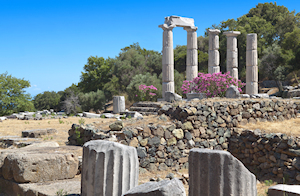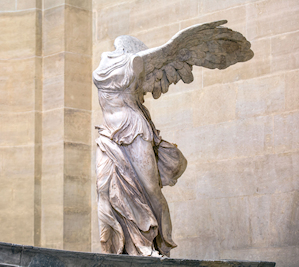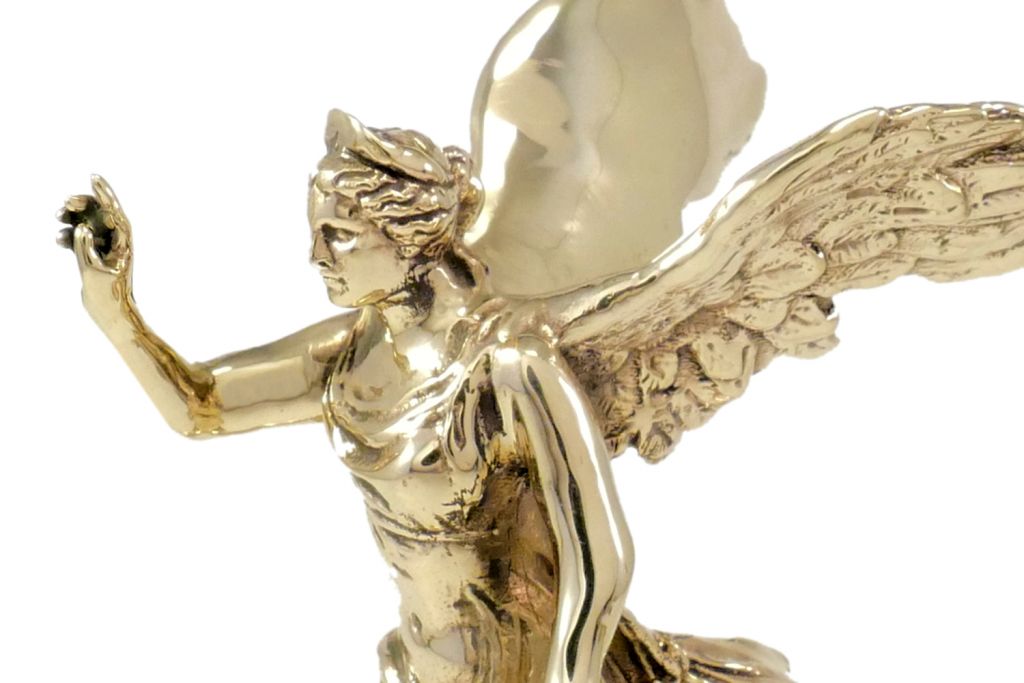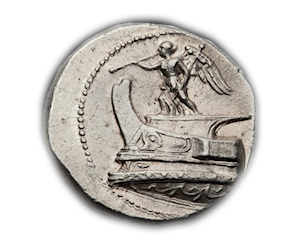Victory Statue, Bronze, Nike of Samothrace
Small statue of Victory, inspired by the famous Victory of Samothrace. Possible reconstruction in style of a roman Lararium`s figure.
Victory statue, bronze
Small statue of Victory, inspired by the famous Victory of Samothrace. The wonderfully detailed figure of the ancient goddess of victory is a reconstruction of the larger-than-life Victory (or greek Nike) statue from the Louvre in Paris. Unfortunately, the ancient work of art has survived only as a fragment without head and arms, which is extremely unfortunate. On the other hand, this circumstance also offers me the opportunity to bring this masterpiece back to life in an idealized form. Based on comparative findings and current scientific reconstruction proposals, the statue of the Victory of Samothrace was created in miniature as it might have once looked.
As a victorious figure in an authentic Roman house altar (Lararium), she is a real eye-catcher, but also friends of antiquity, collectors or lovers of Hellenistic art will be thrilled. Analogous to preserved lararium figures, we did not place the statue of the Victoria of Samothrace on a ship's bow, but, as with many other miniaturized variants from Roman times, on a globe.
The figure is made entirely by hand and cast in elaborate technique in lost wax casting of solid bronze. Then as now, the figure is an outstanding piece of art.
Height of the figure approx. 93 mm
Video:
The goddess Victory - The Roman religion and its deities
At the time of the early republic, the Romans had an independent, rural religion in an agricultural society, which is difficult to find archaeologically. The main focus was on powers of fertility and protective deities for humans and animals.
With the expansion of the Roman sphere of power and the contact with Etruscans and Greek colonies, the beliefs changed. The ancient gods were increasingly adapted to the Greek cult and equaled. On the one hand, there were the twelve known "Dei Consentes," which, according to the beliefs of the Greeks, represent the gods of Olympus. These included Jupiter as the supreme god, as well as Juno, Neptune, Minerva, Mars, Venus, Apollo, Diana, Vulcanus, Vesta, Mercury and Ceres. In addition, there were numerous other gods such as Aeolus, the god of the wind, Luna, the goddess of the moon or Fortuna as a goddess of fortune.
A peculiarity of the Greek and Roman religions are personifications of qualities and virtues, such as Justitia, the goddess of justice, Pax as a goddess of peace, Virtus (valor), Concordia (concord) or Victory (victory). Deities were also considered to be personifications of certain cities, countries and peoples, such as Roma, the patron goddess of the city of Rome. The enthusiasm of the Romans for the Greek culture meant that the appearance of the gods and their representation in the arts were adopted almost identically. Many outstanding Greek sculptures and statues are no longer preserved in the original, but still exist today as copies from later Roman times.
In addition to the public cult of the state gods, there was the private cult practiced on house altars within families and households. Here, especially private guardian gods of the house and its inhabitants were worshiped, the Laren and Penaten, as well as the genius as guardian spirit of the host, the "Pater Familias" as the head of the extended family.
Other gods, which had a special bond in the form of oaths, promises or personal fortunes, were worshiped in private worship. Above all, Mercury as God's trade and money is often to be found as a small figure of gods in the house altars, the so-called Lararien.
Victoria
The goddess Victory is the personification of victory, happy departure and peace. She is a winged deity, which also expresses the fleeting nature of success. The Roman Victory corresponds to the Greek goddess Nike. Their attributes are the laurel wreath and the palm branch, both of which were also awarded as awards to the winners of sporting competitions.
In the Curia Julia, the assembly building of the Senate in Rome, the statue of the goddess of victory had an outstanding position. Victoria also appears frequently on Roman coins when a military success was propagated by the emission of a new series of coins. Thus, the goddess of victory becomes a central figure for the imperial claim of the emperors and the Roman self-understanding in general. She was thus also the personal patron goddess of the emperor.
Until the modern era, the representation of the goddess of victory enjoys great popularity. In Berlin she sits enthroned as the "Goldelse" on the Victory Column and on the Quadriga at the Brandenburg Gate.
The Victoria / Nike of Samothrace
On the Greek island of Samothrace, not far from the Bosphorus in the northern Aegean, there was a large sanctuary of the Kabirs in Greek times. This was originally a mystery cult, which was later identified with the deities of Demeter, Persephone, Hades and Hermes and had a connection to the underworld. On the island of Samothrace, they were the protector of seafarers and castaways. Just before the dangerous passage Marmara Sea and further through the Bosphorus into the Black Sea one needed the assistance of the gods. It was open to all seekers of help, regardless of religion and origin. Within a day one was introduced to the cult, which is why the sanctuary was also very popular and well visited.
After the abandonment of the temple, probably after an earthquake, the buildings became a quarry. The blocks were crushed and burned to lime or transported directly to other construction sites. The ruins soon fell into oblivion and were eventually overgrown by nature again.

The remains of the complex were discovered in 1863 by Charles Champoiseau and examined in a probing excavation. On the last day of the campaign, the excavators finally discovered the fragments of a larger than life marble statue. Champoiseau recognized from the feathers and wing fragments that it had to be a statue of Nike. Unfortunately, the search for the poor and the head of the figure was unsuccessful even in modern diggings.
The remains were shipped in crates in the direction of Paris, where the items were finally put together laboriously.

The statue of Nike was set up in a relatively small, walled area around 13 x 9 meters, on the edge of the sanctuary of Samothrace, which had been partially buried in the rising terrain. It may be a well, which could indicate clay pipes in the area. In one of these clay pipes, during excavations in 1950, traces of the right hand were discovered, which, like the statue itself, are now exhibited in the Louvre in Paris. Previously, a reconstruction of the Nike with a trumpet in the right hand was considered, analogous to antique coin pictures.
| Delivery time | 3-4 weeks |
|---|---|
| weight | 0.150000 |
| size | 93 mm |
| Era | Romans |
| Material | Bronze |
| Kind of replica | Gods and cult |
| scope of delivery | Delivery in a jewellery case with certificate |


